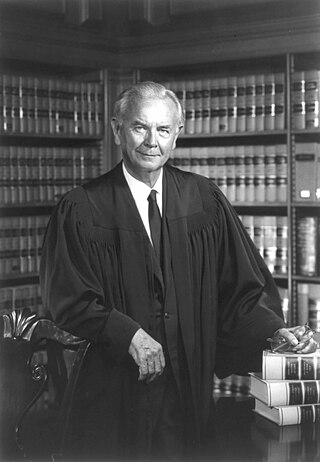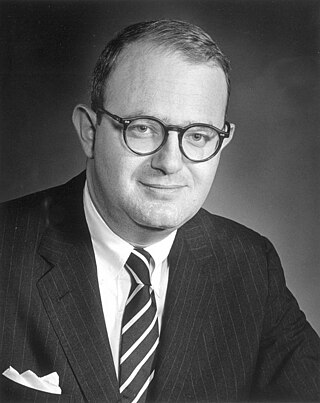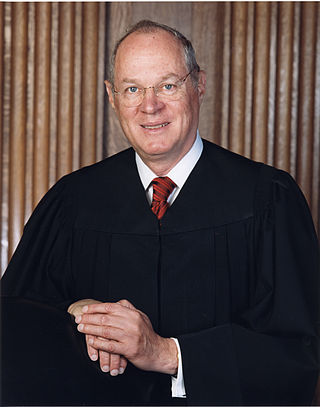Related Research Articles

The Supreme Court of the United States (SCOTUS) is the highest court in the federal judiciary of the United States. It has ultimate appellate jurisdiction over all federal court cases, and over state court cases that involve a point of U.S. constitutional or federal law. It also has original jurisdiction over a narrow range of cases, specifically "all Cases affecting Ambassadors, other public Ministers and Consuls, and those in which a State shall be Party." The court holds the power of judicial review, the ability to invalidate a statute for violating a provision of the Constitution. It is also able to strike down presidential directives for violating either the Constitution or statutory law. However, it may act only within the context of a case in an area of law over which it has jurisdiction. The court may decide cases having political overtones, but has ruled that it does not have power to decide non-justiciable political questions.

Sandra Day O'Connor was an American attorney, politician, and jurist who served as an associate justice of the Supreme Court of the United States from 1981 to 2006. O'Connor was the first woman to serve as a U.S. Supreme Court justice. A moderate conservative, O'Connor was known for her precisely researched opinions. Nominated by President Ronald Reagan, she was considered a swing vote for the Rehnquist Court and the first four months of the Roberts Court. Before O'Connor's tenure on the Court, she was an Arizona state judge and earlier an elected legislator in Arizona, serving as the first female majority leader of a state senate as the Republican leader in the Arizona Senate. Upon her nomination to the Court, O'Connor was confirmed unanimously by the United States Senate.

The Federalist Society for Law and Public Policy Studies (FedSoc) is an American conservative and libertarian legal organization that advocates for a textualist and originalist interpretation of the U.S. Constitution. Headquartered in Washington, D.C., it has chapters at more than 200 law schools and features student, lawyer, and faculty divisions; the lawyers division comprises more than 70,000 practicing attorneys in ninety cities. Through speaking events, lectures, and other activities, it provides a forum for legal experts of opposing views to interact with members of the legal profession, the judiciary, and the legal academy. It is one of the most influential legal organizations in the United States.

David Hackett Souter is an American lawyer and jurist who served as an associate justice of the U.S. Supreme Court from 1990 until his retirement in 2009. Appointed by President George H. W. Bush to fill the seat that had been vacated by William J. Brennan Jr., Souter sat on both the Rehnquist and the Roberts courts.

John Paul Stevens was an American lawyer and jurist who served as an associate justice of the Supreme Court of the United States from 1975 to 2010. At the time of his retirement, he was the second-oldest justice in the history of the U.S. Supreme Court and the third-longest-serving justice. At the time of his death in 2019 at age 99, he was the longest-lived Supreme Court justice ever. His long tenure saw him write for the Court on most issues of American law, including civil liberties, the death penalty, government action, and intellectual property. Despite being a registered Republican who throughout his life identified as a conservative, Stevens was considered to have been on the liberal side of the Court at the time of his retirement.
Lawrence v. Texas, 539 U.S. 558 (2003), is a landmark decision of the U.S. Supreme Court in which the Court ruled that sanctions including any form of criminal punishment to all forms of private, consensual non-procreative adult sexual activities between two individuals are unconstitutional. The Court reaffirmed the concept of a "right to privacy" that earlier cases had found the U.S. Constitution provides, even though it is not explicitly enumerated. It based its ruling on the notions of personal autonomy to define one's own relationships and of American traditions of non-interference with any or all forms of private sexual activities between consenting adults.

Warren Earl Burger was an American attorney and jurist who served as the 15th chief justice of the United States from 1969 to 1986. Born in Saint Paul, Minnesota, Burger graduated from the St. Paul College of Law in 1931. He helped secure the Minnesota delegation's support for Dwight D. Eisenhower at the 1952 Republican National Convention. After Eisenhower won the 1952 presidential election, he appointed Burger to the position of Assistant Attorney General in charge of the Civil Division. In 1956, Eisenhower appointed Burger to the United States Court of Appeals for the District of Columbia Circuit. Burger served on this court until 1969 and became known as a critic of the Warren Court.

Harry Andrew Blackmun was an American lawyer and jurist who served as an associate justice of the Supreme Court of the United States from 1970 to 1994. Appointed by President Richard Nixon, Blackmun ultimately became one of the most liberal justices on the Court. He is best known as the author of the Court's opinion in Roe v. Wade.

William Joseph Brennan Jr. was an American lawyer and jurist who served as an Associate Justice of the Supreme Court of the United States from 1956 to 1990. He was the seventh-longest serving justice in Supreme Court history, and was known for being a leader of the Court's liberal wing.

Laurence Hirsch Silberman was an American jurist and diplomat who served as a United States circuit judge of the United States Court of Appeals for the District of Columbia Circuit from 1985 until his death. He was appointed in October 1985 by President Ronald Reagan and took senior status on November 1, 2000. On June 11, 2008, President George W. Bush awarded Silberman the Presidential Medal of Freedom.

Samuel Anthony Alito Jr. is an American jurist who serves as an associate justice of the Supreme Court of the United States. He was nominated to the high court by President George W. Bush on October 31, 2005, and has served on it since January 31, 2006. After Antonin Scalia, Alito is the second Italian American justice to serve on the U.S. Supreme Court.

The Roberts Court is the time since 2005 during which the Supreme Court of the United States has been led by John Roberts as Chief Justice. Roberts succeeded William Rehnquist as Chief Justice after Rehnquist's death.

The Rehnquist Court was the period in the history of the Supreme Court of the United States during which William Rehnquist served as Chief Justice. Rehnquist succeeded Warren Burger as Chief Justice after the latter's retirement, and Rehnquist held this position until his death in 2005, at which point John Roberts was nominated and confirmed as Rehnquist's replacement. The Rehnquist Court is generally considered to be more conservative than the preceding Burger Court, but not as conservative as the succeeding Roberts Court. According to Jeffrey Rosen, Rehnquist combined an amiable nature with great organizational skill, and he "led a Court that put the brakes on some of the excesses of the Earl Warren era while keeping pace with the sentiments of a majority of the country."
Uttecht v. Brown, 551 U.S. 1 (2007), was a case dealing with jury selection in capital cases in which the Supreme Court of the United States held that appeals courts must defer to a trial judge’s decision on whether a potential juror would be able to overcome demur about capital punishment and be open to voting to impose a death sentence.

The Burger Court was the period in the history of the Supreme Court of the United States from 1969 to 1986, when Warren E. Burger served as Chief Justice of the United States. Burger succeeded Earl Warren as Chief Justice after the latter's retirement, and served as Chief Justice until his retirement, at which point William Rehnquist was nominated and confirmed as Burger's replacement. The Burger Court is generally considered to be the last liberal court to date. It has been described as a "transitional" court, due to its transition from having the liberal rulings of the Warren Court to the conservative rulings of the Rehnquist Court.
Kennedy v. Louisiana, 554 U.S. 407 (2008), is a landmark decision by the Supreme Court of the United States which held that the Eighth Amendment's Cruel and Unusual Punishments Clause prohibits the imposition of the death penalty for a crime in which the victim did not die and the victim's death was not intended.
Speculation abounded over potential nominations to the Supreme Court of the United States by Ronald Reagan even before his presidency officially began, due to the advanced ages of several justices, and Reagan's own highlighting of Supreme Court nominations as a campaign issue. Reagan had promised "to appoint only those opposed to abortion and the 'judicial activism' of the Warren and Burger Courts". Conversely, some opposed to Reagan argued that he could "appoint as many as five Justices" and would "use the opportunity to stack the Court against women, minorities and social justice".

Anthony McLeod Kennedy is an American lawyer and jurist who served as an associate justice of the Supreme Court of the United States from 1988 until his retirement in 2018. He was nominated to the court in 1987 by President Ronald Reagan, and sworn in on February 18, 1988. After the retirement of Sandra Day O'Connor in 2006, he was considered the swing vote on many of the Roberts Court's 5–4 decisions.

The Supreme Court of the United States is the country's highest federal court. The Court has ultimate—and largely discretionary—appellate jurisdiction over all federal courts and state court cases involving issues of U.S. federal law, plus original jurisdiction over a small range of cases.
June Medical Services, LLC v. Russo, 591 U.S. ___ (2020), was a United States Supreme Court case in which the Court ruled that a Louisiana state law placing hospital-admission requirements on abortion clinics doctors was unconstitutional. The law mirrored a Texas state law that the Court found unconstitutional in 2016 in Whole Woman's Health v. Hellerstedt (WWH).
References
- 1 2 Martin Tolchin, Press Is Condemned By a Federal Judge For Court Coverage The New York Times, 6/15/1992
- ↑ Tushnet, Mark. "A Court Divided". Norton, 2005, p. 60.
- ↑ Lithwick, Dahlia. "The Souter Factor". Slate. Retrieved 17 April 2012.
- ↑ Hanson, Jon; Adam Benforado. "The Drifters: Why The Supreme Court Makes Justices More Liberal". Boston Review. Retrieved 17 April 2012.
- 1 2 Baum, Lawrence (2006). Judges and Their Audiences: A Perspective on Judicial Behavior . Princeton, New Jersey: Princeton University Press. pp. 142. ISBN 9780691138275.
- ↑ Shafer, jack. "The Gas Over Linda Greenhouse". Slate. Retrieved 17 April 2012.
- ↑ Aronoff, Roger. "The Greenhouse Effect". Accuracy In Media. Retrieved 17 April 2012.
- ↑ Calame, Byron (8 October 2006). "Hazarding Personal Opinions in Public Can Be Hazardous for Journalists". New York Times. Retrieved 17 April 2012.
- ↑ Wertheimer, Linda. "Supreme Court Reporter Linda Greenhouse Retires". NPR.org. NPR. Retrieved 17 April 2012.
- ↑ Pleszczynski, Wlady. "Strange New Respect". American Spectator. Archived from the original on 28 May 2013. Retrieved 17 April 2012.
- ↑ Johnson, Scott. "An Exceedingly Strange New Respect". Look True North. Archived from the original on 2011-10-13. Retrieved 2012-04-18.
- ↑ Buchanan, Patrick (22 April 2008). "The Greenhouse Effect". Patrick Buchanan. Retrieved 17 April 2012.
- ↑ Berkson, Larry (1978). The Supreme Court and Its Publics. Lexington, Massachusetts: Lexington Books.
- ↑ Davis, Richard (1994). Decisions and Images: The Supreme Court and the Press. Englewood Cliffs, New Jersey: Prentice-Hall, Inc. p. 9. ISBN 0-13-034505-9.
- ↑ Warren, Earl (September 12, 1996). "Statement on Special committee of Supreme Court Decisions".
- ↑ McChesney, Robert W. (2003). "The Problem of Journalism: a political economic contribution to an explanation of the crisis in contemporary US journalism" (PDF). 4 (3): 229–329.
{{cite journal}}: Cite journal requires|journal=(help) - ↑ Davis, Richard (1994). Decisions and Images: The Supreme Court and the Press. Englewood Cliffs, New Jersey: Prentice-Hall, Inc. pp. 17–18. ISBN 0-13-034505-9.
- ↑ Becker, Bernie (7 June 2008). "Justices List Their Assets; Wide Range of Wealth". New York Times. Retrieved 17 April 2012.
- ↑ Baum, Lawrence; Neal Devins (2010). "Why the Supreme Court Cares About Elites, Not the American People". Georgetown Law Journal. 98: 1515–1581. Retrieved 17 April 2012.
- 1 2 3 4 Epstein, Lee; Andrew D. Martin; Kevin M. Quinn; Jeffrey A. Segal (2007). "Ideological Drift Among Supreme Court Justices: Who, When and How Important?" (PDF). Northwestern University Law Review. 101 (4): 1483–1542. Retrieved 17 April 2012.
- ↑ Baum, Lawrence (2006). Judges and Their Audiences: A Perspective on Judicial Behavior . Princeton, New Jersey: Princeton University Press. pp. 138. ISBN 9780691138275.
- ↑ Baum, Lawrence; Neal Devins (2010). "Why the Supreme Court Cares About Elites, Not the American People". Georgetown Law Journal. 98: 1567. Retrieved 17 April 2012.
- ↑ Baum, Lawrence (2006). Judges and Their Audiences: A Perspective on Judicial Behavior . Princeton, New Jersey: Princeton University Press. pp. 140. ISBN 9780691138275.
- 1 2 3 Baum, Lawrence; Neal Devins (2010). "Why the Supreme Court Cares About Elites, Not the American People". Georgetown Law Journal. 98: 1571. Retrieved 17 April 2012.
- ↑ Baum, Lawrence (2006). Judges and Their Audiences: A Perspective on Judicial Behavior . Princeton, New Jersey: Princeton University Press. pp. 147. ISBN 9780691138275.
- ↑ Epstein, Lee; Andrew D. Martin; Kevin M. Quinn; Jeffrey A. Segal (2007). "IDEOLOGICAL DRIFT AMONG SUPREME COURT JUSTICES: WHO, WHEN, AND HOW IMPORTANT?" (PDF). Northwestern University Law Review. 101 (4).
- ↑ Greenhouse, Linda (10 April 2005). "The Evolution of a Justice". New York Times. Retrieved 17 April 2012.
- ↑ Baum, Lawrence (2006). Judges and Their Audiences: A Perspective on Judicial Behavior . Princeton, New Jersey: Princeton University Press. pp. 141. ISBN 9780691138275.
- ↑ Simon, James (1994). "Judging the Justices". Stanford Law Review. New York: Pantheon Books. 49 (1): 173–180. doi:10.2307/1229375. JSTOR 1229375.
- ↑ Trapp, Mark. "Kennedy's Benchmarks". American Spectator. Archived from the original on 14 June 2012. Retrieved 17 April 2012.
- 1 2 Eastland, Terry (February 1993). "The Tempting of Justice Kennedy". The American Spectator. 26 (2): 32.